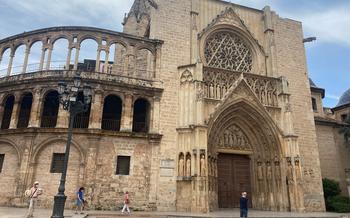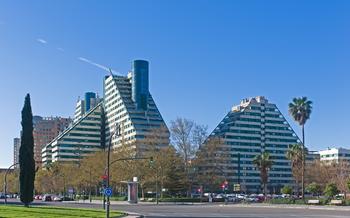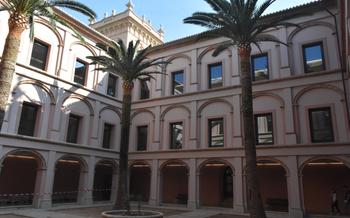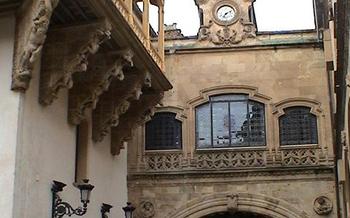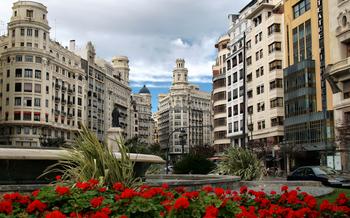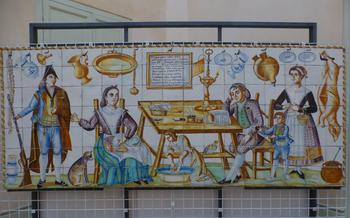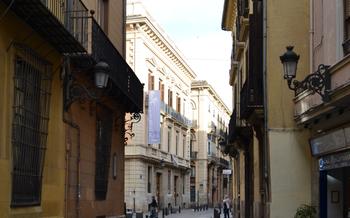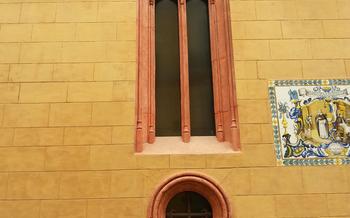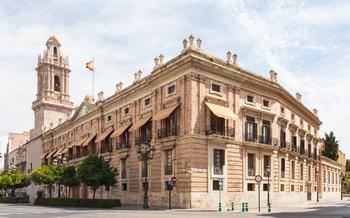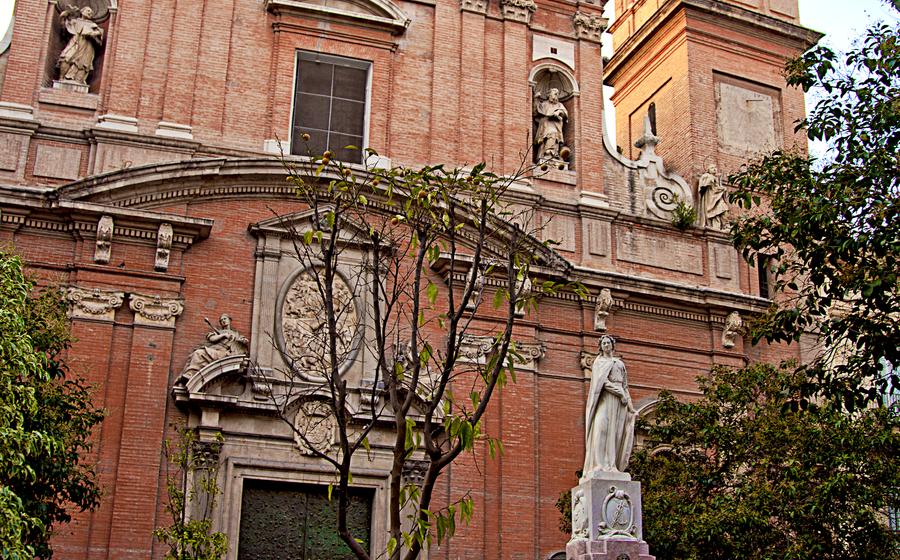
Iglesia de Santo Tomás y San Felipe Neri
- A Baroque Gem
- Architectural Masterpiece
- The Legacy of San Vicente Ferrer
- Beyond the Walls: Exploring Valencia's Treasures
- Planning Your Visit
- Immersive Experiences
- Capturing the Essence
- Restoration and Preservation
- Insider Tip: Unveiling the Secret of the Forgotten Chapel
A Baroque Gem
In the heart of Valencia's historic center, where ancient stones whisper tales of a rich past, stands the Iglesia de Santo Tomás y San Felipe Neri, a breathtaking masterpiece of Baroque architecture. Founded in the 16th century, this church has witnessed centuries of devotion, community gatherings, and the unfolding of Valencia's vibrant history.
Beyond its religious significance, the church played a pivotal role as a gathering place for the local community. Within its sacred walls, people from all walks of life came together to celebrate festivals, mourn losses, and seek solace in times of need. The church became a symbol of unity and resilience, a place where the community's spirit thrived.
One local story that encapsulates the church's significance occurred during a particularly harsh winter. A group of impoverished families, struggling to survive the bitter cold, sought refuge within the church's walls. The parish priest, moved by their plight, organized a collection of food, clothing, and blankets among the wealthier parishioners. The church became a sanctuary of warmth and kindness, a testament to the power of community and the enduring spirit of generosity.
Architectural Masterpiece
The Iglesia de Santo Tomás y San Felipe Neri is a stunning Baroque masterpiece that showcases the grandeur and artistry of this architectural style. The exterior facade is a breathtaking sight, featuring intricate carvings, sculptural details, and a grand entrance that invites visitors into a world of devotion and awe. The interior layout is equally impressive, with a spacious nave, side aisles, and a series of chapels that create a sense of harmony and unity. The dome, vaults, and columns soar overhead, creating an atmosphere of grandeur and reverence. The church's architecture reflects a blend of influences, including Gothic, Renaissance, and Baroque styles, showcasing the diverse artistic heritage of Valencia. Visitors can admire the intricate details, such as the ornate cornices, delicate moldings, and beautifully crafted stained glass windows, which contribute to the overall splendor of this architectural gem.
The Legacy of San Vicente Ferrer
The Iglesia de Santo Tomás y San Felipean saint who played a pivotal role in the city's history. Born in Valencia in 1350, San Vicente Ferrer was a Dominican friar known for his powerful preaching and his tireless efforts to promote peace and reconciliation. His teachings and miracles earned him widespread devotion, and he became one of the most influential figures in the religious and cultural life of Valencia.
The church is home to several relics and devotional objects associated with San Vicente Ferrer, including a fragment of his jawbone and a statue depicting him holding a book and a lily. These relics draw pilgrims and devotees from all over the world who come to pay homage to the saint and seek his intercession.
Each year on April 5th, the church celebrates the feast day of San Vicente Ferrer with a grand festival. The streets of Valencia come alive with processions, music, and dancing as people honor the saint's memory. The festival culminates in a solemn mass held inside the church, where the relics of San Vicente Ferrer are displayed for veneration.
Visitors to the Iglesia de Santo Tomás y San Felipe Neri can learn more about the life and teachings of San Vicente Ferrer through guided tours and informative displays. By exploring the church's rich history and connection to this beloved saint, visitors gain a deeper understanding of Valencia's cultural and spiritual heritage.
Beyond the Walls: Exploring Valencia's Treasures
Strolling beyond the majestic walls of the Iglesia de Santo Tomás y San Felipe Neri, visitors embark on a journey through Valencia's vibrant tapestry of history and culture. Just a stone's throw away lies the Mercado Central, a bustling marketplace brimming with local delicacies, fresh produce, and the infectious energy of Valencian life. The air fills with the tantalizing aromas of paella, freshly baked pastries, and exotic spices, inviting visitors to indulge in the city's culinary delights.
A short walk from the church leads to La Lonja de la Seda, a UNESCO World Heritage site and a testament to Valencia's prosperous past as a center of trade. This architectural masterpiece, built in the 15th century, served as a hub for silk merchants and traders, its intricate carvings and soaring pillars echoing the city's opulence and global connections.
To fully immerse in Valencia's rich heritage, visitors can embark on a leisurely walking tour, starting from the church and weaving through the labyrinthine streets of the old city. Along the way, they will stumble upon hidden plazas, charming boutiques, and architectural gems that tell the story of Valencia's diverse past. A visit to the Museo de Bellas Artes de Valencia, housing an impressive collection of Spanish art from the Middle Ages to the present day, offers a deeper dive into the city's artistic legacy.
For those seeking authentic Valencian cuisine, a culinary adventure awaits in the surrounding streets. From traditional tapas bars to Michelin-starred restaurants, Valencia's gastronomic scene offers a symphony of flavors that will tantalize even the most discerning palates. A glass of refreshing horchata, made from tiger nuts and a local specialty, is the perfect way to cool down after a day of exploration.
Whether it's shopping for souvenirs at the Mercado Central, marveling at the architectural wonder of La Lonja de la Seda, or savoring the culinary delights of Valencia, venturing beyond the walls of the Iglesia de Santo Tomás y San Felipe Neri unveils a world of hidden treasures, inviting visitors to experience the vibrant essence of this captivating city.
Planning Your Visit
When planning your visit to the Iglesia de Santo Tomás y San Felipe Neri, it's important to consider the following factors:
-
Opening Hours: The church is generally open to the public from Monday to Saturday from 10:00 AM to 1:00 PM and from 4:00 PM to 7:00 PM. It is closed on Sundays and religious holidays.
-
Admission Fees: There is no entrance fee for the church. However, donations are welcome and contribute to the preservation and maintenance of this historic landmark.
-
Guided Tours: Guided tours of the church are available upon request and can be arranged in advance. Guided tours provide a deeper insight into the history, architecture, and significance of the church.
-
Best Time to Visit: The best time to visit the church is during the morning or late afternoon when the lighting conditions are ideal for photography and capturing the intricate details of the architecture and artworks.
-
Accessibility: The church is wheelchair-accessible, with ramps and elevators available to assist visitors with disabilities.
-
Combining Attractions: The church is located in the heart of Valencia's historic center, making it easy to combine your visit with other nearby attractions such as the Mercado Central, La Lonja de la Seda, and the Valencia Cathedral.
Immersive Experiences
To fully immerse yourself in the essence of the Iglesia de Santo Tomás y San Felipe Neri, consider attending a mass or religious service. Witnessing the church's spiritual atmosphere firsthand is a deeply moving experience. The solemn chanting, the flickering candles, and the palpable devotion of the congregation create a truly awe-inspiring ambiance.
Participate in local festivals or events held in the church or the surrounding area to immerse yourself in Valencia's vibrant religious and cultural traditions. These events offer a unique opportunity to witness the church's role as a community gathering place and to experience the deep connection between the Valencian people and their faith.
For a truly hands-on experience, consider volunteering or getting involved in community activities organized by the church. This is a wonderful way to give back to the community, meet like-minded individuals, and gain a deeper understanding of the church's social and charitable work.
Finally, learn about the local customs and traditions related to the church and its significance. Engage with the locals, ask questions, and observe their interactions with the church. This will provide you with a richer and more meaningful understanding of the church's place in Valencian society.
Capturing the Essence
The Iglesia de Santo Tomás y San Felipe Neri offers a wealth of photographic opportunities, both inside and out. To capture the grandeur of its Baroque facade, position yourself at a slight distance to take in its full scale and intricate details. Experiment with different angles to emphasize specific features, such as the elaborate carvings or the towering bell tower.
Venturing inside, the church's opulent interior presents a treasure trove of photographic subjects. The ornate ceiling frescoes, intricate altarpieces, and delicate sculptures beg to be captured in all their glory. Use a wide-angle lens to encompass the sweeping vistas of the nave and side chapels. Pay attention to the interplay of light and shadow, which can dramatically enhance the mood and atmosphere of your photographs.
For a unique perspective, explore the church's hidden corners, such as the choir loft or the sacristy. These secluded spaces often reveal fascinating details that might otherwise go unnoticed. Experiment with different vantage points and focal lengths to create compelling compositions that showcase the church's architectural and artistic wonders.
Remember to be respectful of the church's religious significance and avoid using flash photography during services or other sacred events. By following these guidelines, you can capture the essence of this magnificent church and preserve its beauty for generations to come.
Restoration and Preservation
The Iglesia de Santo Tomás y San Felipe Neri has undergone several restoration and preservation efforts throughout its history. Following the damage sustained during the Spanish Civil War, extensive restoration work was carried out in the 1940s and 1950s to repair the structural damage and restore the church to its former glory. This involved meticulous restoration of the intricate carvings, frescoes, and other decorative elements that adorn the church's interior and exterior.
In recent years, ongoing conservation projects have focused on preserving the church's original features and preventing further deterioration. These projects have included cleaning and restoration of the facade, structural reinforcement, and the conservation of artworks and artifacts within the church.
The ongoing efforts to restore and preserve the Iglesia de Santo Tomás y San Felipe Neri are essential for ensuring that this architectural masterpiece remains a source of pride and inspiration for generations to come. These efforts are a testament to the importance of preserving our cultural heritage and safeguarding landmarks that hold significant historical and artistic value.
Visitors to the church can appreciate the dedication and skill of the artisans and conservators who have worked tirelessly to restore and maintain this architectural gem. By preserving the church's original features, we can ensure that future generations can continue to marvel at its beauty and learn about its rich history.
Insider Tip: Unveiling the Secret of the Forgotten Chapel
As you wander through the depths of the Iglesia de Santo Tomás y San Felipe Neri, keep an eye out for a hidden gem – the Capilla del Santo Cristo de la Fe. Tucked away in a secluded corner, this chapel holds a captivating secret that few visitors know about.
Step inside, and you'll find yourself in a world of hushed reverence. The walls are adorned with intricate frescoes depicting scenes from the life of Christ, casting a warm glow upon the sacred space. The centerpiece of the chapel is a magnificent altarpiece, showcasing a finely carved wooden crucifix that is said to date back to the 16th century.
Legend has it that this crucifix was once the object of a miraculous event. During the Spanish Civil War, when the church was under siege, a stray bullet pierced the crucifix, leaving a visible mark that can still be seen today. Locals believe that the crucifix miraculously stopped the bullet from harming anyone inside the chapel, a testament to its protective powers.
To fully appreciate the hidden beauty of the Capilla del Santo Cristo de la Fe, visit during the early morning hours when the soft sunlight filters through the stained glass windows, casting an ethereal glow upon the chapel's interior. Take a moment to sit in quiet contemplation, marveling at the intricate details of the artwork and the profound stories they convey.
Whether you're a history buff, an art enthusiast, or simply someone seeking spiritual solace, the Capilla del Santo Cristo de la Fe offers a unique and unforgettable experience. Discover this hidden treasure and let its sacred atmosphere transport you to a realm of wonder and devotion.
